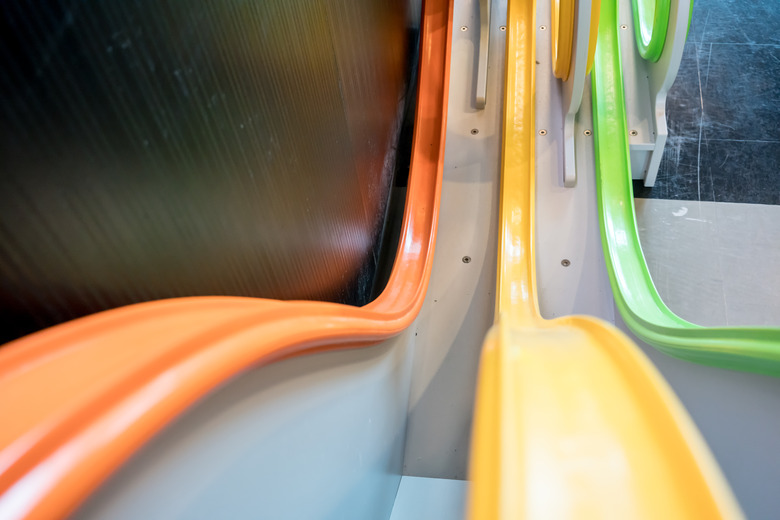Science Project: The Effect Of Mass On The Distance A Ball Travels
The link between mass and the distance a ball travels when released from a ramp reveals a key fact about gravity and how it works. The project is a great way to illustrate the link between gravitational force and mass and can be set up in a classroom or at home. Rolling balls of different masses down an elevated ramp reveals the effect of mass on the distance traveled. This simple project also provides a useful introduction to designing scientific experiments, so the variable you're considering is the only one that affects the results. If you're looking for an illuminating yet straightforward science project, investigating the effect of mass on the distance a ball travels is a fantastic choice.
Things Needed
- A
wrapping paper tube or a flat piece of wood to use as a ramp. - Three or more balls
of different masses. (Ideally the same size and material but different weights. Any
diameter that fits in your ramp is suitable.) - Four
or five textbooks or something else to elevate your ramp. - Scissors
- Kitchen
scales or something else to measure the mass of your balls. - Measuring
tape or a meter ruler - Notebook
and pen - (Optional)
A paper cup or small cardboard box
Step 1: Set Up the Experiment
Step 1: Set Up the Experiment
Set up the experiment by elevating one side of your ramp. Cut your wrapping paper tube in half lengthwise using your scissors to create a long U-shaped track for your balls. Stack your textbooks (or put your other object) in the place you've chosen for the start of your ramp. Make sure you have plenty of space in front of the ramp to allow the balls to roll and come to a stop.
If you don't have a lot of space, you can place a cup or small cardboard box at the base of the ramp, with the opening facing the ramp, so it catches the ball after it rolls down. The cup or box substantially reduces the distance traveled, but the ball will still move it. Alternatively, reduce the elevation of your ramp to reduce travel distance.
Finally, you need to measure the distance the ball travels. The easiest way to do this is with measuring tape. You can simply wait for the ball (or cup/box) to stop and then measure the distance from the bottom of the ramp to its final resting place. Alternatively, you can use a meter ruler to mark out a series of 1-meter increments from the base of the ramp, and then make a more precise measurement later using the ruler and your existing markings.
Step 2: Measure the Mass of Your Balls
Step 2: Measure the Mass of Your Balls
Measure the mass of your balls to help you interpret your results. It's crucial that you have a set of balls (three or more) that have different masses. If you can't do this precisely, the most important thing is that you can rank them from lightest to heaviest, but if you have a set of kitchen scales, measure their precise masses and make a note of them.
Step 3: Record Your Measurements
Step 3: Record Your Measurements
Roll each ball down the ramp multiple times and record how far it travels from the base of the ramp. Taking three or more measurements of each will provide a more reliable result. Take your measurements as accurately as possible, but repeating each test multiple times will help minimize the impact of any mistakes. For each ball, add the individual measurements together and divide by the number of measurements to find the average. Go through this process for each of your balls and record the rules in a notebook.
Step 4: Interpreting Your Results
Step 4: Interpreting Your Results
The results should show that the heaviest ball travels the farthest before stopping. This is because the force of gravity depends on the mass of the object it's pulling. Gravity pulls the balls down the ramp, and the force of gravity is bigger on larger-mass objects. The extra force on the bigger ball means that it has more energy when it gets to the bottom of the ramp and consequently travels more before stopping.
The force of friction (between the ball and the ground) eventually slows the ball to a stop. Friction depends on the mass of the object too, but the link between mass and acceleration shown by Newton's second law also means that it takes more force to slow down a bigger object. Make sure that you use identical balls (in every way you can) and release them from the same height. Also, make sure they roll on the same material throughout their journey, and these effects should cancel out. An object that's twice as heavy should roll roughly twice as far before stopping.
This is why good experimental design is important because any other differences between tests could affect your results. Ideally, the only difference between your tests should be the mass of the ball.
Cite This Article
MLA
Johnson, Lee. "Science Project: The Effect Of Mass On The Distance A Ball Travels" sciencing.com, https://www.sciencing.com/science-project-effect-mass-distance-ball-travels-2550/. 28 April 2018.
APA
Johnson, Lee. (2018, April 28). Science Project: The Effect Of Mass On The Distance A Ball Travels. sciencing.com. Retrieved from https://www.sciencing.com/science-project-effect-mass-distance-ball-travels-2550/
Chicago
Johnson, Lee. Science Project: The Effect Of Mass On The Distance A Ball Travels last modified August 30, 2022. https://www.sciencing.com/science-project-effect-mass-distance-ball-travels-2550/
